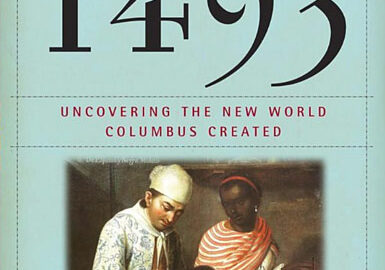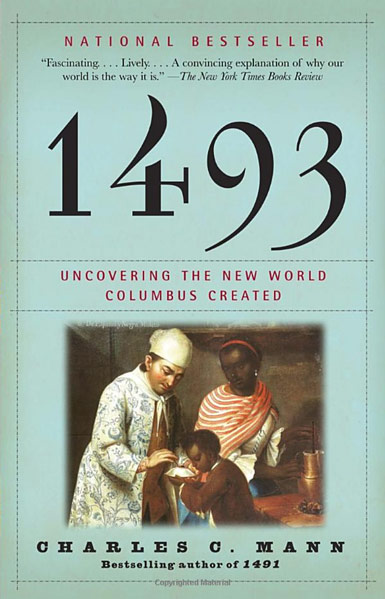
Book Review
1493
Uncovering the New World Columbus Created
Charles C. Mann
Paperback edition 2012
Reviewed by George Kasabov
Contributing Writer
Despite the horrors of conquest and slavery, Post-Columbian trade with the New World transformed world history and marked the beginning of modern globalization. It initiated modern agriculture, the industrial revolution, and even the world’s great cuisines.
For thousands of years there had been a very small, but valuable, trade in luxuries between Europe and the distant east. Silk, porcelain and spices had come by camel and by sea from east to west, but it was a dangerous and demanding trade and articles that came that way were often worth their weight in gold.

Columbus promised to transform that trade by forging a new route the other way, sailing west across the ocean toward China. To his surprise, he discovered that an unknown New World was in the way. That was in 1492. The next year, 1493, he returned and from that moment the Columbian Exchange began, the interchange between the New World and the Old. This interchange was of plants and animals, of raw materials and technologies, of attitudes and populations, of parasites and diseases; an interchange that has diversified and expanded over the centuries since then.
The Europeans who came as colonists sought wealth and power. They had no qualms about enslaving those they came upon. But they could not know that the parasites they carried with them would have a lethal effect on the locals, millions of whom died, having no resistance to such viruses as smallpox. This caused a problem for the colonists, who, though acquiring empty land more easily, still needed laborers to work their fields and mines. So Africans were brought as slaves. Unlike Europeans and Native Americans, who died of imported diseases such as malaria and yellow fever, Africans were more resistant, as these parasites had always plagued their native continent. And so the system of plantation slavery took hold. The plantations grew the newfound tobacco and cotton as well as the sugarcane, which had come from the moist tropics of South-East Asia.
Another consequence of the great die-off resulting from the new diseases was that much of the native environment was changed. In many areas the indigenous people had operated a system of agriculture that involved sequential clearance of the forests and, in much of Amazonia, enrichment of the ground with charcoal. This system died when the people died. Without their management, the forest soon regrew and either formed dense jungle in equatorial regions or deep forest further north. This was then clear felled for European style agriculture, making the land unrecognisable and, often, less productive.
Slavery was, of course, resented by the slaves and, in areas where there were few colonists, the incoming slaves found it easy to escape and, from 1512, they founded colonies in the jungle. These escapees were called Maroons. They joined up with the Native Indians, forming Afro-Indian polities, particularly in Brazil, the Caribbean, Florida and Central America. Spanish and Portuguese colonists also interbred with the indigenes, often intermarrying with the local ruling class, resulting in the mixed population we find now, a very different pattern from that that of Anglo-North America, and one which has produced a rich mix of Afro-Indian belief systems, some far removed from European ones.
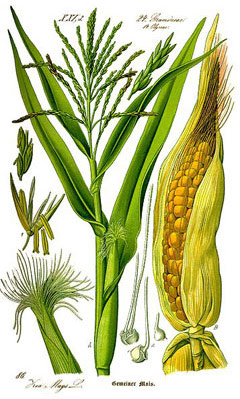
Europeans also imported animals, plants and wheeled carriages. They brought horses, cattle, rats and guns, returning home with Colorado beetles and much else. They brought wheat, carrots and pigs. They took away essential food crops such as corn (maize), paprika, courgettes, beans and tomatoes, without which it would be impossible to imagine European cooking now. They took sweet potato and maize to China, which fed a growing population there. They also took cassava and chillies, now staples of the tropics, and such plants as the avocado. So the hot curries of India, the peppery food of West Africa, the cuisine of China and Indonesia, the food of the Mediterranean, with its tomatoes, beans and paprika, all would be unrecognisable without these imports from the New World.
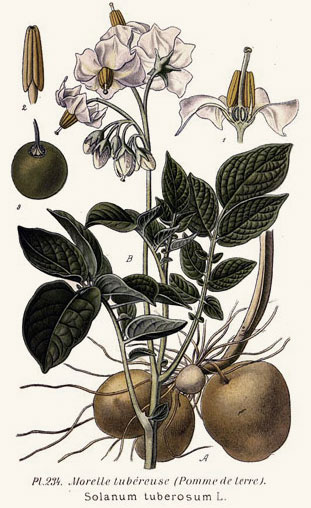
Finally, the Andean potato was adopted in temperate climes across the world. It is so productive that some claim it fed much of the great human expansion of the last three centuries. It was the tremendous productivity and nutritiousness of the potato that helped overcome the Malthusian trap that faced the growing population as industrialisation began, for potatoes can produce four times more food per acre than wheat and a potato has almost all the protein, carbohydrate, minerals and vitamins that a body needs. However, where too much reliance was placed on this single food, as in Ireland in the 1840’s, crop failure, due to blight, had dreadful consequences.
But there was another New World product that helped feed the growing masses of industrial Europe, guano, the excrement of birds. For millions of years the cold sea currents along the west coast of South America had brought up nutrients from the bottom that fed vast shoals of fish. Great flocks of seabirds swooped on them and bred on islands near the coast; the Chincha islands they are called. Bare islands where no people lived, for their vast cliffs are made of pure guano.

Centuries before Columbus, the Indians had discovered that this guano was an excellent fertiliser and there were trails of llamas loaded with it coming from the coast. But around 1830 the first bags of guano were brought to Europe. A pioneering organic chemist, Justus von Liebig, recognised that the nitrogenous chemicals in guano make a perfect fertiliser for growing plants and, in 1840, published his Organic Chemistry in its Application to Agriculture and Physiology. Forward-looking farmers bought the book and rushed to buy the guano. Their yields doubled or tripled and a guano mania began. In 1841 Britain imported 1,880 tons, by 1845, 219,764 tons and on it went. Modern input-intensive agriculture had begun. The soil was no longer an organic host for plant life. Instead, land became a medium for receiving chemical inputs that would then feed the vegetables planted there. And this all started with the bird shit from the Chincha islands.
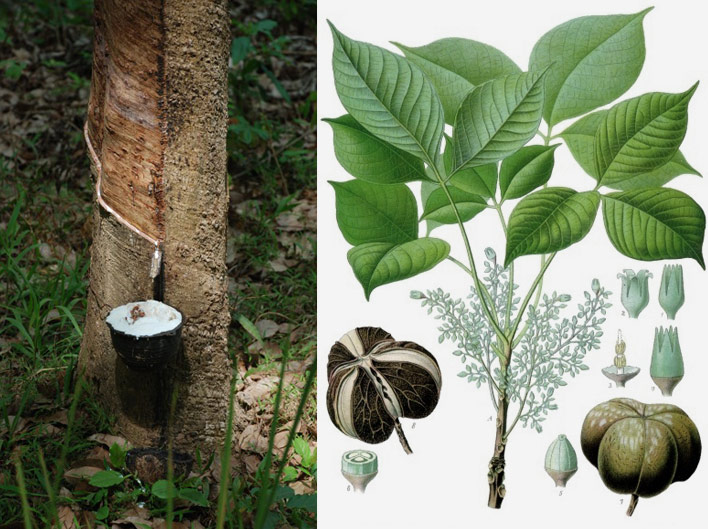
The later industrial revolution would also not have happened without another New World plant, the Pará tree, the sap of which makes rubber. A jungle species, its rubber is essential for vibrating machinery, which needs flexible gaskets, containers and piping. Once vulcanisation was developed in the 19th century, a process that used sulphur to transform the natural rubber into a stronger, more durable and less sticky material, it made the development of modern technology possible. Originally collected from wild trees in the Amazon by gangs of slave-like workers held in ruthless servitude, it made great fortunes for Brazilian bosses, who lived in splendour in Manaus, surrounded by the jungle. Then, in 1876, an Englishman named Henry Wickham smuggled 70,000 Pará tree seeds out of Brazil. These were germinated at Kew Gardens and sent out to form plantations in Britain’s eastern colonies, such as India, Malaya and Ceylon. By 1910 these systematically run plantations were outproducing Brazil’s piecemeal exploitation of the native forests, thus breaking its monopoly and ruining the short lived grandeur of its palaces.

But it was not only with the Old World that the Columbian Exchange took place. The Europeans were determined to trade with China, to get its silks and porcelain. However, China felt it had no need of foreign goods; the only thing it lacked was silver. This the Spanish conquistadors had found in a mountain rich in silver ore in what is now Bolivia, at Potosi. Slaves worked the mine and sent the ingots east to Spain. This changed when two Basque colonists, Legazpi and Urdaneta, were ordered by the Spanish king to sail west across the Pacific in an attempt to find Spice Islands not run by Portuguese and, also more importantly, to find their way to China. Instead, they landed on the Philippines and founded Manila as a Spanish outpost. There, in 1571, Legazpi was met by three Chinese trading junks. They took every ounce of silver he had brought in exchange for Chinese luxuries and thus began a trading system that would transform both China and the colonies.
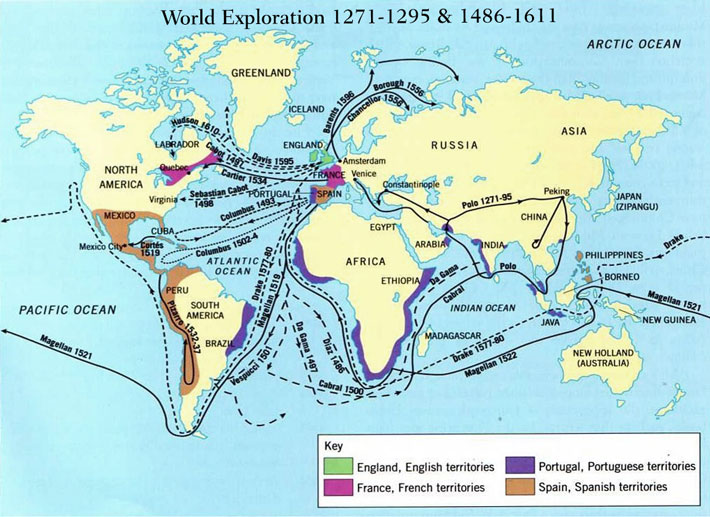
So, for the first time, this “galleon trade”, as it would become known, linked Asia, Europe, the Americas and, less directly, Africa. “Never before had so much of the planet been bound in a single network of exchange – every populous area on earth, every habitable continent except Australia. Dawning with Spain’s arrival in the Philippines was a new, distinctly modern era.” Soon Chinese workers would be seen in the Americas and Japanese Samurai would guard the transport of treasure in Mexico, adding to that universal melting pot which is the continent today.
This is a story that affects us all, yet most know little of it. It is a fascinating story that illustrates the myriad changes that bind us all together; a tale that began in that first year of globalization, 1493, and which has continued to develop throughout the centuries since.
About the Book’s Author: Charles C. Mann is a correspondent for Science and The Atlantic Monthly, author of 1491 and has co-written four previous books including Noah’s Choice: The Future of Endangered Species and The Second Creation. A three-time National Magazine Award finalist, he has won awards from the American Bar Association, the Margaret Sanger Foundation, the American Institute of Physics, and the Alfred P. Sloan Foundation, among others. His writing was selected for The Best American Science Writing 2003 and The Best American Science and Nature Writing 2003.

